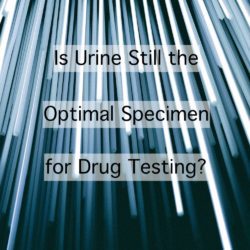This information is provided for educational purposes only. Reader retains full responsibility for the use of the information contained herein.
Until recently, urine lab-based drug testing has been the only specimen approved by the federal government. This includes more than three decades of allowing only one specimen type for testing under the Mandatory Guidelines for Federal Workplace Drug Testing Programs (Mandatory Guidelines). Oral fluid testing is now accepted by the federal government and the Department of Transportation (DOT) is reportedly on the brink of adding oral fluid testing to follow suit.
What Does This Mean?
Without a doubt the new regulations will affect general workplace testing and now is the opportune time to contemplate the “optimal” specimen for your testing needs. However, choosing the optimal specimen for drug testing is determined by a company’s program objectives. Instead of asking which testing method is best, you should be asking which specimen type fulfills the desired outcome of my testing objectives?
The optimal specimens for drug testing are contingent on a variety of factors. Depending on the objectives of your drug testing program, a given specimen type may fit more logically than another and it is important to know the different aspects of each specimen option.
There are four primary specimen considerations for workplace testing:
- Urine
- Saliva/oral fluid
- Hair
- Blood
Each specimen type presents different attributes and while evaluating the “optimal” specimen for your program the following considerations should be contemplated:
- State laws
- Ease and convenience
- Cost
- Detection window
- Federal regulations
This article will highlight the four primary drug testing specimens, integrating each one’s important attributes that play an essential role in determining which specimen fits your company program. Keep in mind that it may be possible that one specimen alone will not meet all testing needs and as employers are evaluating the appropriate specimen type, they may benefit from shifting their interest from a single-specimen program to a combination of different specimens to keep up with the evolution of workplace testing.
Urine specimens
Urine specimen testing is the most common method used and has long been considered the “gold standard” in the eyes of the federal government. However, the paradigm for federal testing is changing and the mindset of general workplace testing will most likely swing in the same direction.
Urine drug testing is approved in all 50 states and urine specimens are relatively easy to collect, though a private restroom is required for collections.
Furthermore, urine specimens can be tested for many illicit drugs as well as prescription medications and are often used in the healthcare industry where workers have access to a wider variety of prescription drugs. Urine specimens usually detect drug use within 1-3 days after drug use. This makes urine a good all-around specimen for most testing situations, including pre-employment, reasonable suspicion, and post-accident.
On the other hand, people have figured out how to cheat on a urine test as it can be easily manipulated by adulterations, substitution, or dilution. To combat this issue, companies may consider observed collections or include language in their policy to allow for retests on results reported as dilute.
Oral fluid specimens
Oral fluid testing appears to be gaining popularity and with product improvements and the updated federal regulations this growth is expected to increase. Most states allow saliva specimens as a method to test for substances of abuse, but as with any specimen restrictions need to be taken into consideration during the evaluation process.
Oral fluid testing does not require a designated collection area which makes it easy to be collected on company premises. This makes the test process more efficient and reduces the amount of time away from work and the collection cost. Furthermore, oral fluid samples are collected under direct observation making it nearly impossible for an individual to adulterate a sample.
With oral fluid testing, the window of detection is shorter. Oral fluid detects recent use, making it an ideal specimen for situations such as marijuana detection. A positive oral fluid test is likely to show that an individual was under the influence or impaired. The detection window typically is within a few minutes of use to up to 48 hours. The short detection window of oral fluid testing makes it a prime choice for reasonable cause and post-accident testing situations. Furthermore, an employer may be less likely to be found in violation of the new OSHA post-accident testing requirements using oral fluid testing because it reveals more immediate drug use.
Hair specimens
Hair testing is the most effective means to determine long-term drug use and provides up to a 90-day window of detection. Hair testing is difficult to adulterate and is an excellent option for pre-employment or follow-up testing situations for employers that want to look at historic use. Due to the testing process, hair specimens will not cover the first several days prior to the test, but is a great option to weed out habitual users. Some individuals searching for a job will abstain from drug use for a few days to pass a pre-employment test using urine or oral specimens. However, it is far less likely for an habitual drug user to refrain from drug use for 90 days to pass a hair test.
On the downside, hair testing has a limited number of substances included in the testing process and the cost of testing is generally more expensive than other specimen options. Hair testing is only prohibited or restricted in a handful of states, giving ample opportunity to consider this specimen option for companies that could increase their program value from the benefits hair testing offers.
Blood specimens
Blood testing is considered an invasive type of drug test and as a result, is used less frequently used by employers. Only qualified individuals are allowed to extract blood samples (phlebotomists or laboratory practitioners) which can make testing more difficult to administer and can be rather costly.
Blood tests are usually administered when other types of testing are not an option, if state laws require an employer to perform a blood draw for workplace drug testing, or if requested by the donor. Drugs in blood are typically detectable within minutes to hours, depending on the drug and the dose, versus one to several days with urine. Since drugs are rapidly metabolized and eliminated from the body, blood analysis offers a very brief detection window. The detection period can be 12 hours or less but may be up to a day or two in some cases.
Which specimen should be used?
Specimen options are dependent on each company’s drug testing needs. Take advantage of CCG’s expertise regarding the suitable specimen selections for your company and policy development. Contact us at 215-240-8204 to learn more about our consulting services and how we can help you update your drug-free workplace policy to include additional testing specimens.



